In part 1 of ‘Fort Gellibrand – Understanding the Trace’ the fortification originally known as Williamstown Central Battery was examined through the gun positions and buildings which still exist on the Fort Gellibrand site. This essay will attempt to establish the initial trace of the fortification in 1860-1865, and the first redevelopment trace which took place in the period 1871-1876. This has been made possible by examining contemporary newspaper descriptions of the Williamstown defences and their armament and by utilizing several drawings from the 1886 redevelopment period of Fort Gellibrand, now held by the National Archive of Australia.
The Williamstown Central Battery was the only one of eleven batteries planned by Sir William Scratchley, R.E. in 1860 for the defence of Hobson’s Bay to include a Redan. This structure appears to have been conceived during the construction period, when it was felt necessary to block uneven ground between the two central 32-pounder gun batteries at Williamstown with a defensive earthen Redan to accommodate riflemen. Unfortunately no fortification plans from this early development period at Point Gellibrand and Sandridge have yet come to light.
The Argus newspaper commented that a Volunteer Militia force was acknowledged as essential to the defence of Port Phillip on the premise that:
However strong the shore fortifications may be, they are able to be turned by a force landed below their range; and there are few places in the port where a disembarkation could not be effected. A land force, therefore, is necessary to support the batteries, either to prevent the disembarkation of the enemy, or to give him battle should he succeed in reaching the shore.
Any approach by an enemy force that might disembark at Western Port, the Mornington Peninsula, along the eastern Port Phillip shoreline, or even the scattering of Bass Strait bays to the west of Port Phillip, could be met by a mobile infantry defence supported by field artillery set within gabion battery structures. The problem of a landing to attack the flank of the batteries at Williamstown was recognized by Scratchley, who had recommended a Martello tower be built to the east of the Right Battery to prevent the enemy attempting a landing and attack on the batteries from the direction of Point Cook.
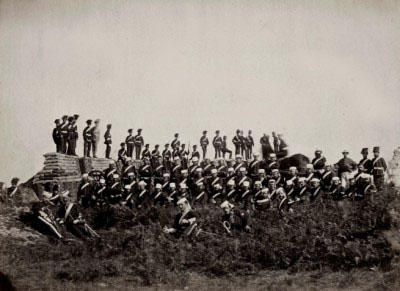
The Central Battery Redan was most likely regarded as an infantry redoubt, and was part of the 1863 decision to maintain:
… a land force (which is) necessary to support the batteries, either to prevent the disembarkation of the enemy, or to give him battle should he succeed in reaching the shore. Thus, while our riflemen would be powerless to protect the city from bombardment (by enemy ships), the batteries which can do this would be nothing without the presence of a land force. The object of the batteries is to keep a hostile fleet from the city; the task of the volunteers to drive an invader from the soil.
On Scratchley’s advice, the Victorian Government was keen to acquire the latest breech loading 80-pdr and 100-pdr Armstrong weapons then being tested. The British Government replied that they could only supply Victoria with smooth bore, 68-pounder, muzzle loading guns until Imperial forces were adequately supplied with the new Armstrong weapons. As a result the Hobson Bay batteries were destined to be fitted out with 32-pdr ML guns already in the colony and the promised 68-pdr ML guns. The Argus lamented that:
The thirty-two pounders are old twenty-four pound pieces rebored, and are quite useless, inasmuch as their accuracy cannot be at all depended upon. They are to be replaced with sixty-eight pounders, a gun which experiments seem to have established as the most effective of smooth bore pieces, and which is now generally used in the defences of the English coast. At its own range, it is held to be more dangerous to shipping than the rifled cannon, for though the latter may penetrate further, the smashing effect of the round shot is more destructive.
32-pdr guns were incapable of inflicting serious damage to a warship at more than 1,000 yards while the 68-pdr guns were considered of little use beyond 2,000 yards. As a result enemy warships would be able to approach the Hobson’s Bay ship anchorage without encountering damaging fire from the shore batteries at Williamstown and Sandridge. In 1863 the Williamstown Central Battery was provided with embrasured 32-pdr guns distributed behind angled earthen wings on either side of the Redan. While plans of the 1862-65 fortifications are not available, it is highly likely that the embrasures of the 1871-76 redevelopments were located in similar gun positions to the original weapons. Most of these positions are established by examining the ‘old battery’ dotted lines shown on various 1889 Fort Gellibrand plans.
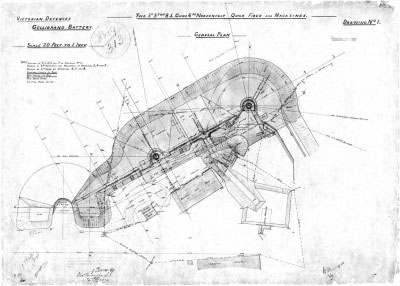
The Argus, in a description of the Hobson’s bay Defence works, reported that:
The central battery, the next fortification, is intended for ten guns, but its present armament consists of seven thirty-two pounders, worked on wooden platforms. This battery, which has been strongly built, with a view of carrying two tiers of guns, has a couple of faces. Owing to the contour of the ground, they are separated from each other but are joined by a Redan-shaped connecting parapet. Inside the face of the Redan, looking southwards, there is a banquette, or continued step, for riflemen to stand upon to fire over the parapet. Here the marksman can remain thoroughly sheltered, and when the crew of the hostile ship get within range he can, like Bailey’s soldier, “pick ’em off like fun”
However, by 1870 when the colony acquired, twenty-four 80-pounder Armstrong RML’s, and six 300-pounder 9-inch, rifled muzzle loading guns, the Central Battery was scathingly dismissed:
A few hundred yards farther along the shore the Central Nine-gun Battery, not nearly as well built as the other. It has wooden platforms for the guns. The last feature shows its unfitness for cannon of a heavier calibre than the obsolete 32-pounders, which is probably the reason why it is dismantled.
While contracts were now let for the technical parts of the stonework and the battery embrasures, convicts were utilized in general labouring duties and in increasing the thickness of the now substantial earthwork. The Author has utilized a 3-D computer graphic program to produce an accurate to scale (3×3 metres per square) rendering of the central Williamstown Battery circa 1876.
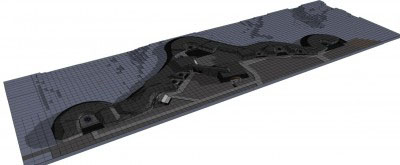
A description of the Central battery in March, 1871 places the progress of work on the battery as:
…stone foundations having been laid for the new guns to work upon, five 80-pounder Armstrong and one 300-pounder Armstrong were removed a distance of about 800 yards and mounted by the convicts. This latter gun weighs 12-tons without its carriage, yet eighteen of them were all that were employed mounting it, so that they must have done a little more than the usual ‘Government stroke’ as affected by those employed at stone breaking and similar jobs. The embrasures of the battery were cut away and made larger, in order to allow of the guns being trained round in all directions, to give them the command of a large radius of the Bay. Originally this battery was nothing better than a mud hole after any rain had fallen, but a substantial stone drain was laid, and the place is now perfectly dry. The facings of the earthworks were thickened and also the roofing of the magazines, so that at present there is a thickness of about 6-feet of earth above the magazines. The whole of the guns and shot having been scraped and lacquered…
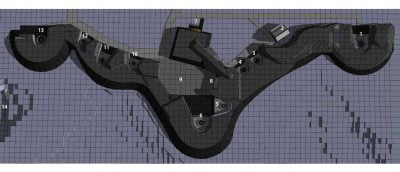
The author believes that in 1876
– the gun at location 1 was a 300-pdr, 9-inch, RML
– the guns at locations 3, 4, 10, 12 were SB 68-pdr ML
– the guns at locations 5, 6, 11, 13 were 80-pdr RML Armstrongs
– site 2 was an artillery store
– site7 was the 1860 powder magazine
– site 8 was the ready use/fuse magazine
– site 14 was the nearest of several basalt quarries
For some reason gun positions 3 & 4 were removed in 1885, to be replaced by a gun shed with doors opening directly onto the old position. By 1886 this shed may have contained two 80-pdr RML guns on wooden carriages – apparently allowing for direct fire of the weapons over the earthwork. These two guns were probably used for Garrison Artillery training.
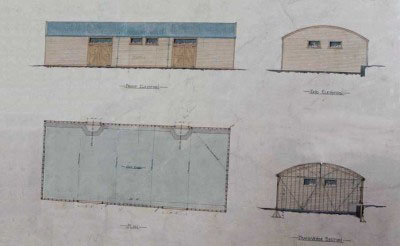
Fort Gellibrand entered its third stage of armament with the addition of a 5-inch 3-ton BL gun on a HP mount in the embrasure at the western end of the battery, circa 1887- 1889. 1889 saw the addition of a major new magazine complex, to serve two 5-inch, BL guns on HP mountings, as well as a 6-pdr Nordenfeldt QF gun mounted on a balanced pillar, located on the upper parapet. The mass concrete and brick structures from this third development stage remain basically unaltered to the present day.
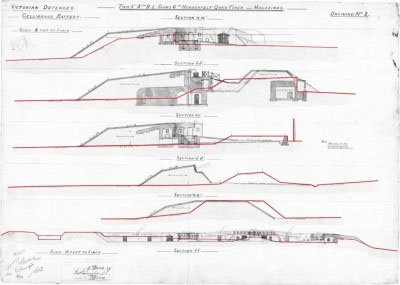
Bibliography
The Argus 22 July 1863 and 8 September 1870
NAA Drawing Victorian Defences Gellibrand Battery, 5-inchBL 3-ton gun on HP Carriage, Drawing 2 – 1887 – barcode 3346251
Contact Keith Quinton about this article.






